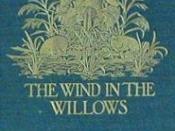The Wind in the Willows, by Kenneth Grahame, allegorically relates to the concept of a journey. Not only does this extract describe the arranging of a physical journey but also it illustrates different people's connotations of and responses to the idea of a journey. This excerpt shows that The Wind in the Willows can be interpreted and enjoyed by children and also examined on a deeper level by adults. The author, Kenneth Grahame, has successfully conveyed the two possible levels by the development of characters and the use of techniques including simple ideas, colourful language, enthusiastic dialogues and the use of active and passive voice.
Though this novel was written for children, it has been enjoyed throughout time by adults as well. It features the adventures of animal characters - principally Mole, Rat, Badger and Toad who each possess recognisable human characteristics, while still exhibiting authentic animal habits.
It is in this sense an allegory: this means it has relevance beyond the surface adventures of these animal characters. It tells us something about human attitudes and behaviours. Primarily though, the novel was composed for children - the author has allowed the characters to be animals which creates an element of fantasy - that animals are capable of talking and performing human tasks. The use of personification has effectively conveyed the human qualities of these animals. This is perhaps one of the reasons why this novel is such a successful children's story. Wind in the Willows relates well to enthusiastic responders, such as children because of the colourful language, active voice and enthusiastic dialogues. Toad is the main example of this; he is full of energy and excitement. Kenneth Grahame has conveyed Toad's personality through his dialogue and action, using strong verbs and punctuation.
The opening of this...


